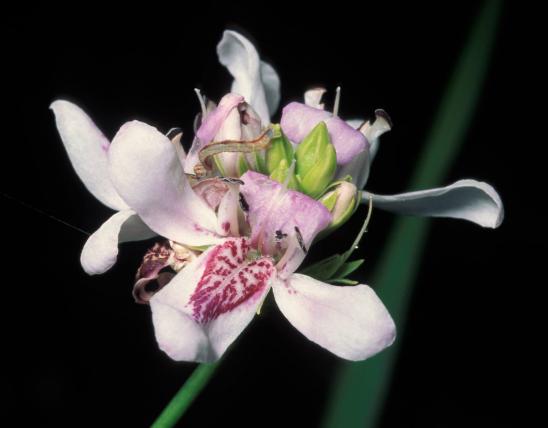
Showy orchis is a perennial wildflower that grows in rich, moist, shady woods, slopes, ravines, and low valleys along streams, often along with other spring wildflowers. It’s about 8 inches tall at flowering time. The plant has 2 (rarely 3) basal, clasping leaves that are dark green, somewhat fleshy, hairless, and smooth, about 2½ inches wide and 8 inches long, with a wide, blunt tip. The flowers arise on the central stem, which is usually about 8 inches long at bloom time. Flowers 3–12 per stem, about 1 inch long, each supported by a leaflike bract; each flower has, above, a pinkish purple, pink, or lavender hood, and below, a white (sometimes pink-tinged), spade-shaped lower lip; in back, the lower lip forms a blunt spur that curves downward. Blooms April–June.
Similar species: This is Missouri’s only member of genus Galearis. Because of its flower color and “showy” name, it might be confused with another Missouri orchid, the showy lady’s slipper (Cypripedium reginae). Lady’s slipper orchids, however, have a noticeably pouched lower lip that resembles the toe of a slipper, hence their name. Also, showy lady’s slipper has the white parts of the flower above and the pinkish-purple parts below, and it is usually a larger plant, with hairy foliage. Finally, showy lady’s slipper is much rarer.
Height: 2¾ to 8 inches.
Scattered nearly statewide, except for the unglaciated Osage Plains of western Missouri and the Bootheel lowlands. Overall range includes much of the eastern United States and Canada, west to Nebraska.
Habitat and Conservation
Lives in moist upland or bottomland forests in rich soil of ravines and valley bottoms or on lower slopes.
Showy orchis typically grows in areas rich in spring wildflowers and is thus one of the better known of the smaller orchids.
Like most other orchids in Missouri, this species grows slowly and reproduces mostly by its slowly spreading rhizomes. This is why showy orchis often occurs in colonies or clumps. When this orchid produces seeds, the germination rate and survival is usually low, because the tiny orchid seeds (with little energy reserves) must germinate in the presence of particular types of symbiotic fungi in order to gain nutrients. Thus this species is difficult to grow from seed.
Status
Native perennial wildflower. Not a suitable candidate for transplanting, as specimens usually die when transplanted.
Human Connections
This is one of Missouri’s most beautiful native orchids. All orchids have obligate relationships with soil-borne, mycorrhizal (symbiotic) fungi, and they do not tolerate environmental changes well. Thus, they do not transplant well into gardens. Please do not dig up orchids from their natural homes. Instead, take photos and videos of your discoveries. Or get even more creative — capture them with a paintbrush, or write a poem or song about them.
This species is listed as vulnerable, threatened, or endangered in several states in its range. The problems involve habitat disruption as well as unscrupulous collecting from the wild. If you are interested in native plant gardening, always get your plants from reputable native plant nurseries. Keep in mind that native orchids are notoriously difficult to transplant.
The genus name, Galearis, is from the Latin word galea, for “helmet” (think of Roman gladiators and centurions!); it refers to the hoodlike part of the flowers. The species name, spectabilis, is about what you might think: it’s Latin for “visible” or “remarkable” — showy; a spectacle — something to see!
Orchis, or orchid? Both words derive from the ancient Greek word for “testicle,” in reference to the paired, fleshy roots of some species of orchids. Orchis is one genus in the orchid family (Orchidaceae), and it’s the type genus for which the family is named. In this case, the showy orchis was originally placed in the genus Orchis, and even though the genus for this plant has changed, the common name “orchis” stuck. (Maybe we should start calling it “showy galearis”?) Meanwhile, the word orchid is a shorthand way of saying “member of family Orchidaceae.”
Ecosystem Connections
The flowers of showy orchis are mostly pollinated by bumblebees. The flower’s white lower lip is a landing platform for the bees.
Globally, there are about 10 species in genus Galearis, and they occur in North America and Asia.
The orchid family is one of the largest families of flowering plants, containing some 28,000 species that have been officially described. Many orchid species that grow in remote areas of the tropics have not yet been officially described. Among the families of flowering plants, the aster family (sunflowers, daisies, dandelions, and other composites) is the other heavyweight, with some 32,000 known species, globally. In both families, species are still being described and added.
Compared to their abundance in the tropics, orchids are much less diverse in temperate areas, and Missouri has only 36 species of orchids (and one of them is introduced). By comparison, Missouri has about 330 species in the aster/sunflower family.
Showy orchis grows in the soil, but in tropical habitats, many orchids are epiphytes: they grow upon other structures, such as tree limbs, and not in soil. Some of these epiphytic orchids are the ones you may see for sale at garden centers and florist shops: Phalaenopsis, or moth orchids, are one of the types commonly sold. To be successful, pay close attention to their growing requirements.
Many Missouri orchids occur only in relatively small populations and produce few fruits. Overcollection and habitat disruption, such as changes in soil moisture, light levels, and density of competing vegetation, have no doubt contributed to the present rarity of some species.



































